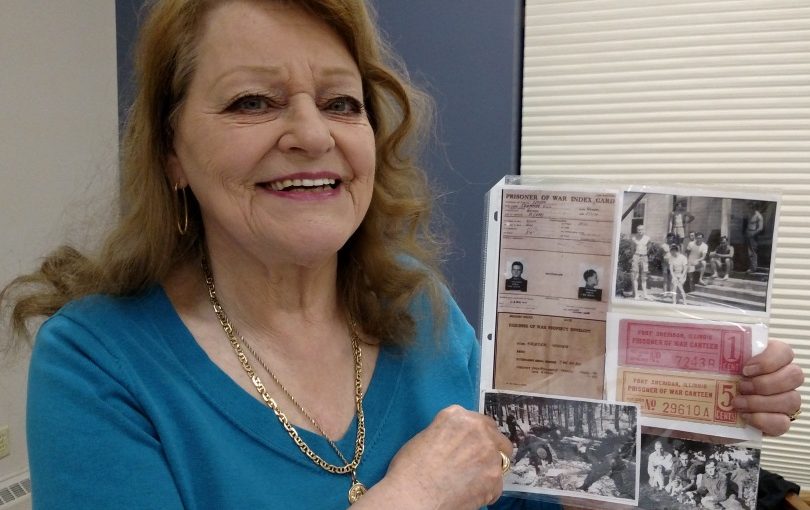Carol Chandler of Dixon, IL, is a retired hospital nurse with a Bachelors’ Degree, who likes to research, write, and share her knowledge with others. She is a member of the Lee County Historical and Genealogical Society Board of Directors. On Monday, October 15, 2018, from 6:30 to 7:30 p.m., she put her interests and talents on display, during a fact-filled program about “German POW’s in Northern Illinois.” The City of Morrison Community Room at Odell Public Library, 307 S. Madison Street, Morrison, IL, held a large, attentive audience.
This free program was part of the fall Lifelong Learning Series sponsored by the Odell Public Library Friends. Chandler is a return LLS speaker; last year she addressed the Orphan Train policy of child relocation to the Midwest.
About two years ago, Chandler discovered WWII “prisoners of war” were held in the United States. That term first was used in the 1660’s. These men “were a very much-needed labor force,” she explained. “There was an acute shortage of production workers.” At first they were housed in former Civil Conservation Corps camps; fairgrounds; sports halls; schools; other public buildings. As prisoner numbers increased, they were held at military bases.
News coverage of the camps was intentionally limited until the end of the war. Initially, prisoners worked in camps doing construction and maintenance. The National labor shortage soon led to requests from business owners for help in canneries, mills, farms, and other places not related to National security. Many camps were in the South, because heating costs were lower there. To make labor available where it was needed, the U. S. Army added 511 “branch camps” to the existing 156 main camps at military bases. Some prisoners lived in the homes of the farmers who needed their labor.
- From August 1943 to May 1945, prisoners at Camp Grant could work 12 hours a day, six days a week. This included travel time to-and-from a site and meal breaks; Chandler estimated they actually toiled closer to eight hours a day.
- Prisoners aged 16-to-25 worked in Sycamore, canning peas.
- Laborers from Barbados first worked at a Sterling cannery, but they were replaced by German prisoners.
- POW’s harvested hemp in Polo, to make twine and ropes for ship rigging.
- In Lanark, 375 Germans were sent to a cannery and food processing plant.
- The Swiss Milk factory in Dixon is believed to have had a prisoner workforce, but Chandler said no information was available.
Between 1942 and 1945, 1073 escaped. Because they had been brought to the U. S. against their will, Chandler noted, they could not be prosecuted. They were not illegal aliens. She offered a list of what happened to 31 escapees. Germany’s “Great Escape” was from Camp Michaux, Cumberland County, PA. On Christmas Eve 1944, 25 prisoners escaped through a 200-foot tunnel. Georg Gartner escaped from Camp Deming, NM, on September 21, 1945, and finally surrendered in 1985–on the “Today” show. Gartner had remained at large for 40 years and now lives in Boulder, CO. He was the last German POW to be discovered and is now 93 years old.
One Italian and one German POW committed suicide rather than be repatriated. They are buried just outside the post cemetery in Fort Lawton, WA. Two Italian and 33 German POW’s are buried in the post cemetery at Fort Meade, MD. Chandler has compiled a list of 42 WWII prisoners buried in Illinois.
By the end of the war, nearly 400,000 POW’s lived in camps in 46 States. Of those, only 50,000 returned directly to Germany after the war. Many went to Great Britain as slave laborers. Europe suffered from dire food shortages during after the war, while prisoners in the United States had thrived.
“Five percent of the POW’s came back to live in the United States. It was possible in the United States to live in a decent, prosperous society, without heavy handed indoctrination” they had known as youth in Germany. Grandfathers brought their descendants to meet Illinois families that had treated them with kindness as young men.
Chandler holds a collage of historical items that illustrate humane treatment of German prisoners in Illinois. At top-left is a POW Index (ID) Card. Illustrating payment for work at Fort Sheridan, IL, center-right, are denominations of 1¢ and 5¢ Canteen scrip. She stated the United States Government paid 50-to-60 cents an hour and 80 cents a day, using scrip. Three group photographs of POW’s indicate a measure of freedom while working or at leisure.

